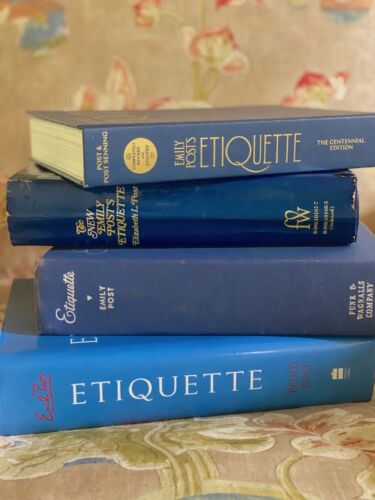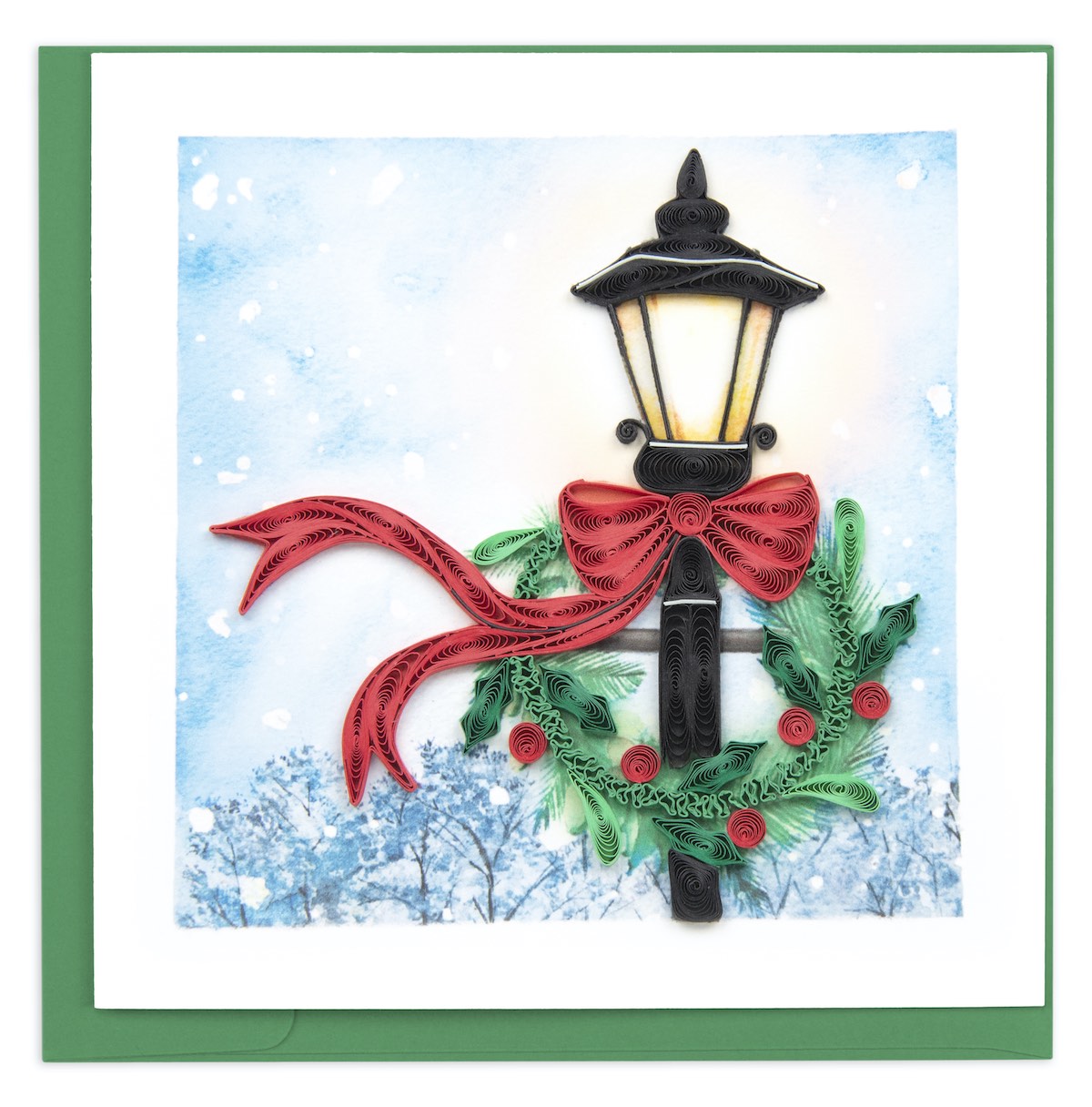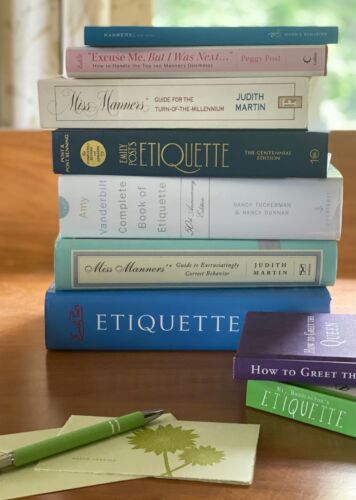In 1922, Emily Post authored the gold-standard guide to what was proper (and what was not) when navigating the complex ways of good society. While the importance of good manners never changes, sometimes the “rules” do. Throughout the last century, Post’s descendants have continued her legacy, adapting and revising her advice in subsequent editions to keep up with the times. As a case in point, we examine the evolution of stationery style for women.
100 Years of Stationery Etiquette
 1922 (First Edition): “Paper should never be ruled, or highly scented, or odd in shape, or have elaborate or striking ornamentation…Colored linings to envelopes are at present in fashion…Young girls may be allowed quite gay envelope linings, but the device on the paper must be minute, in proportion to the gaiety of the color.”
1922 (First Edition): “Paper should never be ruled, or highly scented, or odd in shape, or have elaborate or striking ornamentation…Colored linings to envelopes are at present in fashion…Young girls may be allowed quite gay envelope linings, but the device on the paper must be minute, in proportion to the gaiety of the color.”
1945 (8th Edition): “White, cream, all blues, grays, and mauves are in best taste. Pink is on the fringe of admittance, green is still a tabu [sic]…Ink may be violet as well as any blue but not green.”
1975 (13th Edition): “White, cream, light blue, gray, or light green are the proper colors for the ‘conservative’ paper for formal correspondence, and also for business letters. For personal letters there are no longer many restrictions, and a woman may choose any pattern or combination of colors that pleases her…Ink should match the printing or engraving, or should be chosen to complement the color of the paper.”
2004 (17th Edition): What was once considered “proper” stationery is now but one of many choices, having given way to papers that reflect the writer’s personality.
2022 (Centennial Edition): Type, color, and graphics options are infinite. More informal social stationery can use playful colors, fonts, patterns, and images. For formal styles, choose simple, clean lines and classic colors. Cards and sheets are paired with matching envelopes.

Send holiday greetings in a card that can become a lasting keepsake! Each Quilling Card is delicately handcrafted and comes with a blank insert to include your own personal message. The collection of holiday cards captures the spirit of the season and makes a great addition to home décor when framed. See more at quillingcard.com.
Sponsored by Quilling Card
More Words of Wisdom from the Etiquette Experts
Here’s further counsel on correspondence from four decades of etiquette tomes for your advisement and in some cases, purely for enjoyment. After all, how many offices still have a franking machine?

“In a world where most correspondence is disappearing, rest assured that the time-honored thank-you note is going absolutely nowhere. Expressing gratitude is always in vogue.” — Mr. Boddington’s Etiquette: Charm and Civility for Every Occasion (2018)
“Notes are less formal or structured than letters. The date goes on the upper right, the salutation is a line down on the left, the next line down starts the body, followed by a closing on the lower right and your signature or initials.” — Emily Post’s Etiquette: The Centennial Edition (2022)
“Until a child can make some scribbles of his or her own, thank-you notes should come from you… Around the age of five or so, however, encourage your child to write a sentence or two. Don’t worry about the results: the recipient will be charmed by the wayward handwriting and whatever is written. Over time, the act of sending a note will take root; expect full growth by the age of fourteen.” — Kate Spade, Manners (2004)
“A formal dinner party requires a formal, written thank-you note. Pizza back at the house does not.” Judith Martin, Miss Manners’ Guide for the Turn-of-the-Millennium (1989)
“Try not to dillydally when sending out a thank-you note. Your goal is to post it within one week of the gift’s receipt, or within three months for a wedding gift. The exception is a thank-you note for a condolence gift or a gift received during an illness or convalescence. Pen those notes as soon as you are feeling up to it; alternatively, have a friend or relative write a note on your behalf.” — Mr. Boddington’s Etiquette: Charm and Civility for Every Occasion
“The ink should match the nature of the correspondence. For example, for a condolence note or a reply to a formal invitation, black or dark blue is most suitable. For less formal notes, you may use another color ink if you wish.”— Mr. Boddington’s Etiquette: Charm and Civility for Every Occasion
“That gentlemen appear first in the traditional designation of a married couple, Mr. and Mrs., should not be allowed to go to their heads. Given the choice whenever other forms are used, including the salutations, the lady’s name appears first.”—Judith Martin, Miss Manners’ Guide to Excruciatingly Correct Behavior (1983)
“A handwritten letter should always begin ‘Dear So and So.’ The casual ‘Hello’ or ‘Hi,’ or the omission of a greeting altogether, belongs in the world of email, and not always there.” — Caroline Taggart, How to Greet the Queen and Other Questions of Modern Etiquette (2014)
“Neatness counts. Not all penmanship is created equal, but you can control the overall look of a letter. Spilled coffee, a bent piece of paper and words crossed out are all telltale indications of a letter best left unsent. For the recipient, the appearance of your letter is a stand-in for you.” — Kate Spade, Manners
“While it’s okay to write on the front and back of a page, try to make sure your ink doesn’t bleed through, making it hard to read.” — Emily Post’s Etiquette: The Centennial Edition
“A postcard is like a friendly wave from afar, a quick note to say hello—though if your writing is small you can say quite a lot!”— Emily Post’s Etiquette: The Centennial Edition
“A good thank-you note greets the recipient, thanks them, and wishes them well. A great thank-you note goes into a little more detail. Both are completely acceptable.” — Emily Post’s Etiquette: The Centennial Edition
“A comforting note is personal and not long. Those struggling with a loss shouldn’t have to wade through long-winded condolences.”—Peggy Post, Excuse Me, But I Was Next (2006)
“Cards that include a message written by the greeting-card company always require the addition of a personal note of your own. Though your added note can be brief, it must mention the gift or the occasion.” — Emily Post’s Etiquette: 17th Edition (2004)
“Keeping in touch means writing one’s sentiments with one’s very own hand. This may be a full letter, or only the words ‘Merry Christmas’ added to a picture card, but one must write it oneself.” — Judith Martin, Miss Manners’ Guide to Excruciatingly Correct Behavior
“No matter how bad your handwriting is, condolence letters and replies to formal invitations are handwritten.” — Amy Vanderbilt Complete Book of Etiquette, 50th Anniversary Edition (1995)
“If you’re a guest of friends for a night or longer, write them a letter of thanks, known as a ‘bread and butter’ letter, no more than three days after the visit.” — Amy Vanderbilt Complete Book of Etiquette, 50th Anniversary Edition
“‘Cordially’ in a letter closing is a word that Miss Manners, and other authorities before her, particularly dislike. Conventions were invented specifically to allow a person to retreat from having to make choices in situations open to misinterpretation. ‘Sincerely yours’ is a perfectly good closing, neither cold nor warm…It is a general rule to err on the side of formality rather than of intimacy.” — Judith Martin, Miss Manners’ Guide to Excruciatingly Correct Behavior
“In earlier days, the complimentary close of a letter—the word or phrase that precedes your signature—was long and flowery, but it has gradually been pruned. Even ‘Kindest regards’ has almost disappeared, while ‘Sincerely yours,’ ‘Best wishes,’ and ‘Yours truly’ are often shortened to ‘Sincerely,’ ‘Best,’ and ‘Yours.’” — Emily Post’s Etiquette, 17th Edition
“For a flat correspondence card, place it in the envelope so that the recipient will remove it with the printed side up. Place a folded stationery sheet or fold-over note card into the envelope with the fold at the top so the recipient can open the fold and see the text right-side up.” — Mr. Boddington’s Etiquette: Charm and Civility for Every Occasion
“Envelopes containing personal letters should always be handwritten. Her Ladyship deplores the modern habit of using printed labels for Christmas cards, though she admits that in resisting this she is simply making the sending of cards more of a chore. But for a one-off letter, particularly of thanks or condolence, there is no excuse.” — Caroline Taggart, How to Greet the Queen and Other Questions of Modern Etiquette
“Envelopes should always be addressed in black or dark-blue ink for best legibility. No need to strain the eyes of your postmaster!” — Mr. Boddington’s Etiquette: Charm and Civility for Every Occasion
“You may assume that a letter you send to someone’s house will be opened only by the person you are writing to. It’s therefore rude to other members of the family to mark such a letter ‘Personal.’ If, however you are writing a purely social, and perhaps confidential letter to someone at his or her office where the mail may be opened by an assistant, you may write ‘Personal’ on the lower left-hand corner of the envelope.” — Amy Vanderbilt Complete Book of Etiquette, 50th Anniversary Edition
“Never put a personal letter—particularly one of thanks, congratulations, or condolence—through the office franking machine. It would be a shame to spoil the good impression writing a letter makes by indicating that you are too mean to pay for your own stamps.” — Caroline Taggart, How to Greet the Queen and Other Questions of Modern Etiquette
By Karen Carroll
More Works on Paper



